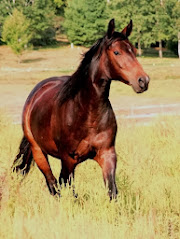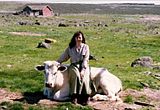Ah! It has been a rough couple of weeks. We've had about 3 exams per week for the last 4 weeks, but now, I'm on vacation! I'm not going to think about school at all this week! Today, I am picking up a friend visiting from far far away, and we are going to spend all week playing with horses! She wants to learn to trim her own horses, so I'm going to show her what I know and let her try her hand at it. I've got 4 horses that need to be trimmed right now, so we have plenty of feet to practice on! AND I get to show her around my home grounds. I just wish the weather was going to be nicer. This is the icky transition time right now. Our nice clean snow is steadily disappearing with the 40 degree weather, and mud and horse manure that piled up over the winter is slowly appearing. And it's supposed to rain this week. Ugh! After a few weeks of sunshine, I'm mad that it will be raining over most of my spring break! I'll probably post some hoof trimming pictures. Wish us luck! I have to trim Kachina too. Griffin is the only one of my horses that is good to go.
Over this last weekend, I participated in a bovine hoof trimming workshop. There are actual hoof trimmers for cows out there! They obviously focus primarily on dairy cattle. Boy, beef cattle would be a handful to try to trim. It was amazing to see the differences between how to trim cows and horses, both in the mechanisms in trimming and in restraint. Obviously, cows are not trained to willingly pick up feet for you and stand nicely so you can trim their feet. They have these specially designed chutes that you load the cow through, her head goes into a head lock, the rear door closes, and then you raise two sling-like straps that she walked over when she came in. These straps go around her thorax and belly and hold her up. Then you attach webbed straps to each leg, around the cannon bone, and two at a time (one back hoof and one front hoof) you raise the leg into working position. And the way the leg is restrained is intesting. You basically crank it up again a bar that holds it perfectly immobile. The rear leg is pulled back, much like like how we do horses, and the front leg is lifted up and to the side a bit (also just like with a horse). Then the trimmers (usually a team of two, from what our instructors were saying) go to town trimming!
Cows hooves need to be at an optimum sloped angle of about 52 degrees (compared to about 45-55 for front and rear on horses). Cows get all the same problems horses do too, especially with their super high concentrate diets that their bodies are not designed to handle. Did you know that ruminants in general (including cows), were actually designed to handle poorer quality forage than horses need? It's because a cow can get most of her protein from the microbes in her rumen (and those microbes can use plant parts that the animals cannot utilized and turn it into protein). Horses, on the other hand, have to get all their protein from their diet. They cannot use the protein in their "fermentation vat" because it is in the hindgut, and all the proteins are absorbed from the digestive tract before then. Proteins cannot be absorbed in large amounts in the colon. In cows, the fermentation vat is the first compartment, so everything that comes out of it can be used by the cow. It's amazing to think about that. I know I thought before that all these high sugar grasses developed for cattle were because they need that and horses don't, but in reality, it's not true. The only reason that we feed cattle such high concentrate diets is to force more milk and meat out of them. And doing that puts cattle always on a metabolic cliff, so to speak. They are so close to being beyond what they can handle metabolically...and we do often see cattle that have problems due to their diet. Anyway, I thought that bit of knowledge I've gained so far in vet school was fascinating. Back to hoof trimming.
So, because of how we manage cattle (feed high concentrate diets, live in manure and muck, standing in it most of the day, in the case of dairy cattle - often living on concrete, which is very hard on their hooves due to lack of cushion, plus we make them carry these huge milk bags between their hind legs), many cattle develop abcesses in their hooves due to irritation of the corium between the pedal bone (coffin bone), and the hoof wall. They also develop hairy warts between their digits, dermatitis, and laminitis, all which can cause them to become lame. A lame dairy cow produces less milk due to the discomfort, so most dairies these days trim. Trimming has helped prevent lameness, as has the installation of water baths containing hoof treatments that the cows much walk through when they are finished milking.
It's hard to describe the difference between the mechanisms of trimming horses and cows. Their hoof shapes are obvously very different and cows have two claws, instead of one on each foot. But other than that, the basics are the same. Cows have a rear cushion area (like a horse's frog), and the front hard digging area with a sole. The sole, hoofwall, and corium are the same as in a horse, but just a different shape due to the shape of the bone underneath. Think of a cow's "coffin" bone as being 1/2 of a horse's...and so two halves make a whole! The "frog" on a cow is not grooved like a horse's. In fact, the whole bottom of the hoof is pretty flat, and the junction between the cushion and the sole is very blended, almost indistinguishable. Pastured cattle will develop a concave sole (concave toward the midline of the hoof, so that with the two toes together, there is a round concave portion in the middle between them such that the outside of each toe contains the hoof wall and bears the weight). Cattle that are kept in free stall barns where the floor contains a lot of areas with concrete, and their feet remain wet from tracking through manure, often have softer soles and hoof walls, so their feet wear more and wear so that they are flat. Because they lack concavity on the inner surface of each hoof, abcesses form easily because the back of the pedal bone is not cushioned. This can also happen in cattle with overgrown hooves.
Trimming a cow involves trimming the toe to the correct length (I think that length was 3.5 inches), scultping the sole to get the desired toe angle (in a long hoof, this involves trimming away the excess sole at the toe, being sure to leave enough for cushion), then scooping out the inner toe area to create the concavity to allow cushioning of the rear part of the pedal bone. Now, here is where it is different from trimming a horse. On the cows there is a weight bearing "sound" toe (which in 95% of the time, this is always true - in the hind limbs, the "sound" toe is the inner toe, in the forelimbs, it is the outer toe). 95% of the abscesses always occur in the "unsound" toe, due to unaccustomed percussion of the bone. So, the hoof shape is trimmed to the "sound" toe, and then the "unsound" toe is trimmed more aggressively, and in most cases you really trim the heel down so that it is shorter on the unsound toe. On the "sound" toe, you don't touch the heel at all because the cow needs that to walk on. Also, on the unsound toe, you really model the concavity on the inner toe. As you do that, you often uncover abcesses that haven't surfaced yet. Modeling like that will relieve the pressure inside the hoof, and shortening the heel will "rest" that toe to give it a chance to heal. In really bad abscesses, they will actually put a 1/2 inch to 3/4 inch wooden block on the "sound" toe to prevent the unsound toe from bearing any weight to give it a chance to heal. And that apparently doesn't hurt the sound toe at all, to be bearing all the weight itself. Crazy. The workshop was so interesting.
So, the first day, we had lectures in the morning, then trimmed cadaver feet to practice. Then the next day, we went out to a dairy barn and ran live cows through chutes and trimmed them up! As vets, it will be very important for us to recognize causes of lameness that might be due to lack of trimming (or bad trimming).
Another interesting thing I learned - a cow's back should be perfectly flat and horizontal with the ground. If you see a cow with a hunched back when she is standing or walking, she is lame, even if she doesn't overtly appear to limp. We trimmed a poor cow with a huge abscess coming out the top of her hoof that was due to an overgrown wart that was invading her hoof. She was so lame and was trying so hard not to put weight on that back hoof, but that is really hard to do when you have that huge milk bag hanging between your legs. She got a block on the healthier toe - the wort was invading the "unsound" toe.
Sorry for the long winded discussion on cows, but I'm learning a lot!












